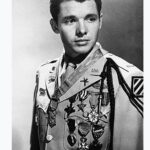
Audie Leon Murphy (20 June 1925 – 28 May 1971) was an American soldier, actor, and songwriter. He was widely celebrated as the most decorated American combat soldier of World War II, and has been described as the most highly decorated enlisted soldier in U.S. history. He received every military combat award for valor available from the United States Army, as well as French and Belgian awards for heroism.
Murphy received the Medal of Honor for valor that he demonstrated at age 19 for single-handedly holding off a company of German soldiers for an hour at the Colmar Pocket in France in January 1945, before leading a successful counterattack while wounded.
Murphy was born into a large family of sharecroppers in Hunt County, Texas. After his father abandoned them, his mother died when he was a teenager. Murphy left school in fifth grade to pick cotton and find other work to help support his family; his skill with a hunting rifle helped feed his family.
After the attack on Pearl Harbor in 1941, Murphy’s older sister helped him to falsify documentation about his birthdate in order to meet the minimum age for enlisting in the military. Turned down initially for being underweight by the Army, Navy, and the Marine Corps, he eventually was able to enlist in the Army. He first saw action in the 1943 Allied invasion of Sicily; then in 1944 he participated in the Battle of Anzio, the liberation of Rome, and the invasion of southern France.
Murphy fought at Montélimar and led his men on a successful assault at L’Omet quarry near Cleurie in northeastern France in October. Despite suffering from multiple illnesses and wounds throughout his service, Murphy became one of the most praised and decorated soldiers of World War II. He is credited with killing 241 enemy soldiers.
After the war, Murphy embarked on a 21-year acting career. He played himself in the 1955 autobiographical film To Hell and Back, based on his 1949 memoirs of the same name, but most of his roles were in Westerns. He made guest appearances on celebrity television shows and starred in the series Whispering Smith. Murphy was a fairly accomplished songwriter. He bred quarter horses in California and Arizona, and became a regular participant in horse racing.
Because Murphy had what would today be described as post-traumatic stress disorder (PTSD), then known as “battle fatigue”, he slept with a loaded handgun under his pillow. He looked for solace in addictive sleeping pills. In his last few years, he was plagued by money problems but refused offers to appear in alcohol and cigarette commercials because he did not want to set a bad example. Murphy died in a plane crash in Virginia in 1971, shortly before his 46th birthday. He was interred with military honors at Arlington National Cemetery.










Leave a Reply